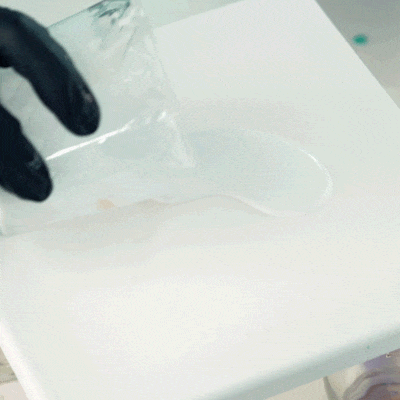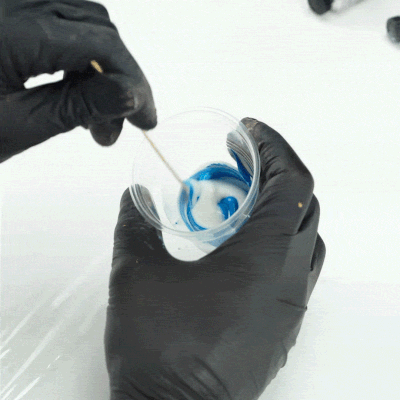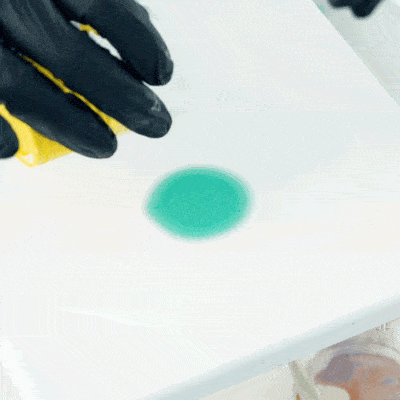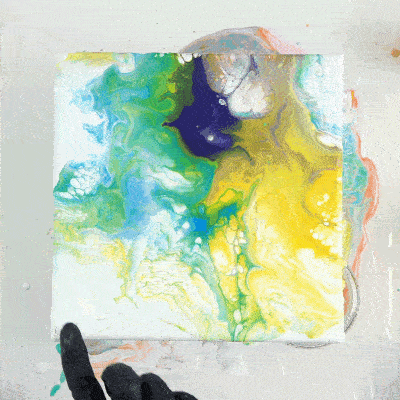Table of Contents:
Paint Pouring Tips for Your Next Painting Project
We met with professional artist Celeste Jones to watch and learn from her as she prepped to pour acrylics for her next amazing work of art.
Pouring acrylic paint on your canvas is a great activity that doesn’t require brushes and it creates unique designs from your favorite color combinations. Although producing high-quality poured art does require a lot of experience and skill, the abstract nature of paint pouring can be ideal for beginners.
To prepare you’ll want to make sure you minimize the mess with this paint medium. Celeste worked over a table that had been covered with plastic wrap before she even poured the paint into the mixing cups. For those of you without a professional workstation, you can also use the inside of a shipping box lined with aluminum foil. This method will make for easy clean up once you have finished the painting.
You’ll need your favorite Arteza Acrylic Paint Set and an Arteza Stretched Canvas for this next step. Once you have your supplies ready to go, set 4 to 6 plastic cups (facing down) so that you can lay the canvas on top of it. This will let it drip off the sides as you work.
To complete your supplies for the activity, you will also need more plastic cups to mix the paint in, coffee stirrers or straws, gloves to protect your hands, and a painting smock or apron. You will also need glue. School glue and some water will do just fine, but for adults and more advanced painters, you can also use a latex-based paint adhesive like floetrol as your pouring medium. It is important to use the right medium in combination with your acrylic paint to make it more fluid.
It is possible to create a beautiful painting just by the way you move the poured paint on the canvas but to get the most dramatic effects, you’ll want to have a hairdryer handy as well.
Step-by-Step Techniques for the Best Acrylic Pouring Art
Step 1: Prepare your glue.


Celeste first poured the bottle of glue into a cup and added a splash of water to get the consistency that was desired. What you want is for your glue to pour easily, but not be too runny. In Celeste’s experience, a ratio of ~1 part paint : 3 parts pouring solution (glue+water ~50:50) offers the best results, but you may develop your preference based on the surface and medium you're working with.


Step 2: Pour the glue on the canvas.


Once your initial round of glue is ready, pour the glue onto the canvas. If it’s too concentrated, you can pick up the canvas and let the glue glide around the canvas for more even distribution. This will act as your primary layer.


Step 3: Mix the glue and the other paints.


You should have a cup for each color you are going to use. Celeste poured some glue into a cup, about 1.5 ounces. She recommends that you add two pea-sized drops of regular acrylic paint. Once you’ve combined the glue with the paint from the tube, mix the glue and the paint using a wooden coffee stirrer (or similar stirring utensil). You will notice that the paint will retain much of its pigmentation, so if you want the paint to look more diluted, use less of it.


Step 4: Make art!


Celeste then got ready to pour the paint. She took each color and poured it one by one. Depending on how much you pour, you may want to move quickly so that it does not begin to dry before you’re ready to use the hairdryer. Remember that the first color you pour will be the primary color in the finished product. For this reason, white is a great starter color for beginners! Once the colors are poured, you can pick up the canvas and swirl it around a bit to create a unique combination.


Step 5: More glue.


To manipulate the paint even more, you can add more of the pouring fluid or glue around the design you’ve created. The paint should react interestingly by marbling the color even more. You’ll notice that wherever the glue is, that is where the paint goes.


Step 6: Use a hairdryer.


Once she let the paint flow to where she wanted it to on the canvas, Celeste used a hairdryer to make the paint form patterns.


Step 7: More paint.


After using the dryer, more acrylic paint can be added to the canvas you are working on. Celeste then used purple to add another pop of color to her artwork.


Step 8: Add glue to the corners.


After swirling the fluid acrylic paint around for a bit, Celeste added more glue to the edges of the canvas. You do this when the paint starts to move around to let your paint get pulled evenly over the sides of the canvas to create a polished finishing look. To add an even more dramatic effect, use the hairdryer again.


Step 9: Time to dry.
Once the piece was ready, Celeste used waxed paper to gently pick up the canvas from the plastic cups and move it over to a safe area of her desk. The thing about acrylic pouring is that depending on how much paint you use, it needs a good amount of time to dry. So she put the painting somewhere out of the way and let it dry overnight.
Last but not least, gather all of your supplies, make sure that any of your clothes with acrylic on it goes right into the wash, and put the caps back on any fluid paint or glue.
Voila! Almost 24 hours later, the canvas with the spectacular poured acrylics had evenly dried and we were left with a magnificent swirled effect. All of her initial preparatory work kept cleanup to a minimum and resulted in a unique art piece that couldn’t be easily reproduced using any other method.
Frequently Asked Questions
How do I know my paints are ready for pouring?
Your paints are ready when you have a creamy texture that isn’t too runny. You can always test your mixture on paper first before you move it to a canvas. Also, consider how concentrated you want the color to be. If you want to dilute the color, you’ll need more glue, and therefore a little more water to maintain the right consistency.
How many colors should I use?
Start with 3-4 different colors of varying shades and a white or a black. That should be enough to achieve a unique poured art effect without overcrowding your piece or increasing the dry time. If you work with black paint, be very careful not to let it bleed into your other colors and gray out your entire canvas. Therefore, Celeste recommends avoiding working with solid black for your first few acrylic pouring projects.
How long will it take for pouring art to dry?
The drying time for paint pouring typically ranges from half a day to 2 days. The factors that affect the drying time include - the humidity level in the drying room, your pouring solution water to glue ratio, how much paint you used, the types of paints and canvases used, and how evenly you’ve distributed the medium.
How do I keep my art safe while it is drying?
The ideal drying area for poured art is a dark, cool, and dry room. This prevents sun damage or uneven drying, while also limiting drying time. Your canvas should be placed on a smooth, cool surface (ideally glass) so that your design dries quickly and evenly.
So, to summarize, this is what we learned from our afternoon of painting with Celeste Jones. Fluid painting is all about the prep. Taking the right precautions and having the right materials heading into your acrylic pouring project is going to make all the difference. Getting your glue solution and paints prepared before diving into fluid painting will ensure that you’re able to add all of the desired colors without running into timing issues with dried paint. This will allow you the optimal amount of time to pick up your canvas, twirl it about and make awesome effects using a hairdryer.
Once your design looks just the way you want it to, find a dark and dry place where your canvas will be safe for 24 hours.
We hope that our time with Celeste has inspired you to try this exciting and fun art form! Remember to stop by our online shop to enjoy free shipping on premium art supplies such as Acrylic Paint Sets and Stretched Canvases.
Watch this step-by-step guide on our YouTube channel.
















21 comments
Hi Brooke! Our pouring acrylics are a pretty new product for us, and we don’t have anything like what you’re referring to at this time, but we do offer pre-mixed acrylic pouring paint for your convenience. If you decide to mix your own pouring paint and experiment with different consistencies, we’d love to hear how it turns out!
Hey Brenda! When painting rocks, the pour paints are virtually the same. The only tip we would mention is that having a slightly thicker consistency may yield the best results.
Could you show us a tutorial on how to do acrylic pours on rocks? Do you need to have a glue solution/to mix paint with glue for rocks? TIA
Hi David, thanks for all this. I am hoping you might have some insight for my on different paint consistencies for different techniques. I saw a chart once that equated “no mound” through “mound on mound on mound” with what techniques each works best for. I have searched everywhere I can think of to find it again, but without success. Have you seen that, or could you make one? Many thanks for your consideration, Brooke
Thanks for sharing a great information. Read more about Paint pouring art at https://acrylicpouring.com/the-complete-acrylic-pouring-techniques-guide/